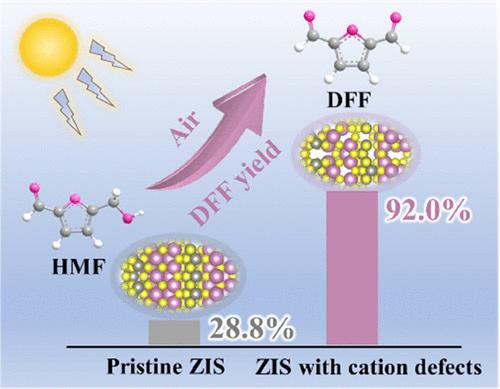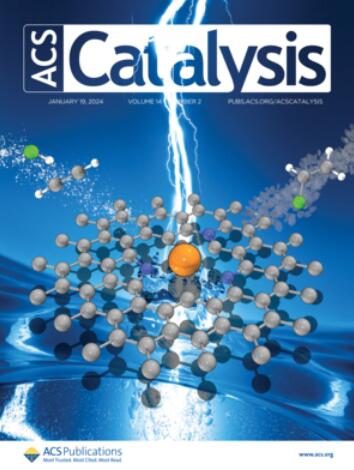Understanding the Role of Dual Zinc and Indium Vacancies in ZnIn2S4 for the Visible-Light-Driven Photocatalytic Air-Oxidation of 5-Hydroxymethylfurfural
IF 11.3
1区 化学
Q1 CHEMISTRY, PHYSICAL
引用次数: 0
Abstract
Defect engineering is an effective strategy to enhance the photocatalytic performance of ZnIn2S4 (ZIS), but it remains a formidable challenge to manipulate the cationic defects in the catalyst because of their high formation energies. Herein, dual Zn and In defects have been successfully created in the ZnIn2S4 (ZIS-5) with a facile cetyltrimethylammonium chloride (CTAC)-assisted hydrothermal method. The resulting ZIS-5, rich in cation vacancies, achieved a 3.6-fold higher 2,5-diformylfuran (DFF) yield (92.0%) than the pristine ZIS (25.8%) for the visible-light-driven photocatalytic air-oxidation of 5-hydroxymethylfurfural (HMF). Especially, ZIS-5 delivers a high DFF productivity of 1600 μmol g–1 h–1, significantly surpassing the previously reported catalysts (75–953 μmol g–1 h–1) for the photocatalytic oxidation of HMF to DFF in air. Density functional theory (DFT) simulations revealed that the presence of dual Zn and In defects endows the catalyst with defect states that intersect the Fermi level and lower work function. These enhance the migration and separation of photogenerated carriers in ZIS-5, significantly promoting O2 activation and resulting in the generation of more reactive oxygen species (·O2– and 1O2) for the catalytic oxidation of HMF. This study offers valuable insights for guiding the design of photoredox reaction systems through cationic-defect-engineering strategies, enabling the efficient valorization of biomass-derived platform chemicals.

求助全文
约1分钟内获得全文
求助全文
来源期刊

ACS Catalysis
CHEMISTRY, PHYSICAL-
CiteScore
20.80
自引率
6.20%
发文量
1253
审稿时长
1.5 months
期刊介绍:
ACS Catalysis is an esteemed journal that publishes original research in the fields of heterogeneous catalysis, molecular catalysis, and biocatalysis. It offers broad coverage across diverse areas such as life sciences, organometallics and synthesis, photochemistry and electrochemistry, drug discovery and synthesis, materials science, environmental protection, polymer discovery and synthesis, and energy and fuels.
The scope of the journal is to showcase innovative work in various aspects of catalysis. This includes new reactions and novel synthetic approaches utilizing known catalysts, the discovery or modification of new catalysts, elucidation of catalytic mechanisms through cutting-edge investigations, practical enhancements of existing processes, as well as conceptual advances in the field. Contributions to ACS Catalysis can encompass both experimental and theoretical research focused on catalytic molecules, macromolecules, and materials that exhibit catalytic turnover.
 求助内容:
求助内容: 应助结果提醒方式:
应助结果提醒方式:


